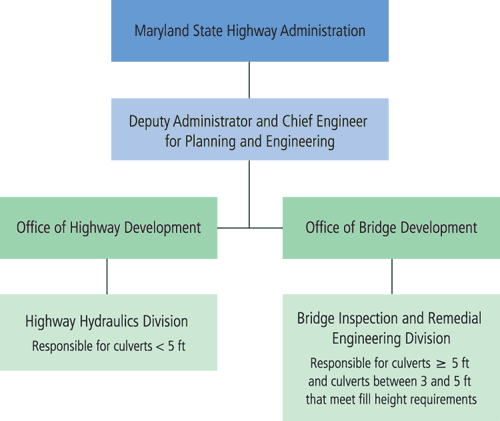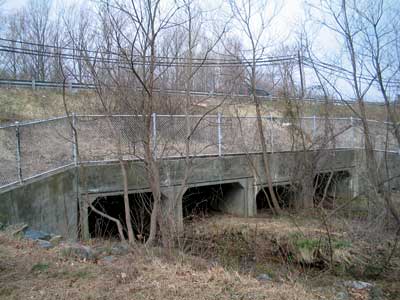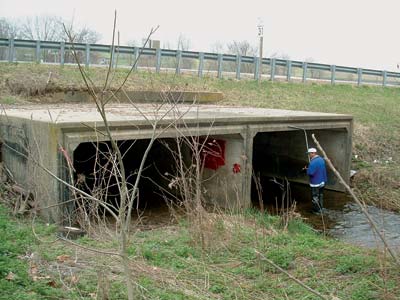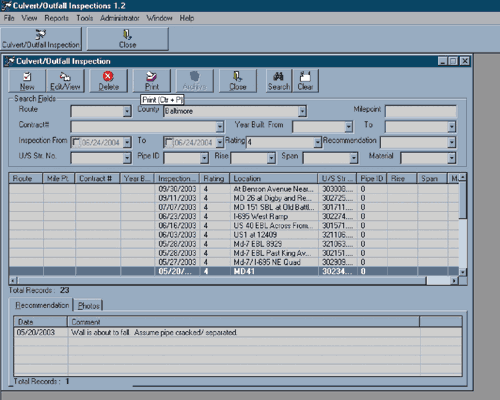Transportation Asset Management Case Studies
CMS Case Study
Maryland
In Maryland the responsibilities for inspection and management of State-owned culverts belong to the State Highway Administration (SHA). The SHA has seven engineering districts, each encompassing several counties. Each district has a headquarters office, which is responsible for managing highway and bridge construction contracts, as well as all maintenance functions, including pavement and bridge repairs. Headquartered in Baltimore, the SHA is responsible for more than 2,500 bridges and more than 16,000 lane-miles of interstate, primary, and secondary roads. In 1996, the agency assumed responsibility for the management and routine monitoring of small structures, including culverts, as a proactive measure. Although no collapse or other event prompted the routine monitoring, the SHA recognized that some smaller structures had structural problems that could lead to failure or other serious consequences.
Division of Responsibilities
Within the SHA, the responsibility for culvert management and inspection is divided between the Bridge Inspection and Remedial Engineering Division (BIRED) and the Highway Hydraulics Division (HHD). BIRED is part of the Office of Bridge Development, and HHD is part of the Office of Highway Development. Both offices operate under the deputy administrator/chief engineer for planning and engineering. Figure 5 illustrates the SHA hierarchy.

The division of inventory and inspection responsibilities is based on culvert size. BIRED typically inspects the larger structures, while HHD handles the smaller sizes. All culverts down to a 5-ft span are inventoried and inspected by BIRED, regardless of height of fill. Culverts from 3 to 5 ft in span are selected for inventory and inspection as follows:
- If the fill height is less than the span length, the culvert is inventoried and inspected at a regular frequency.
- If the fill height is greater than the span length, the culvert is not inventoried or inspected.
This selection process incorporates hazard levels, or consequences of failure, into the inventory and inspection policy. Based on experience, the SHA recognizes that the consequences of failure of a pipe under a small amount of fill are greater than one under a larger fill. A variation of this approach also applies to a battery of culvert pipes. Culverts in Maryland are primarily made of steel or concrete; however, some of the older culverts are made of stone or brick masonry. Although there are a few plastic pipes in the inventory, they are seldom used.
The district offices typically handle routine culvert repair and minor maintenance concerns, such as debris removal. Contract forces sometimes assist with maintenance. After the inspection crew notifies the district office of necessary repairs and maintenance, the district prioritizes the work. The central office is responsible for major repairs that may require an engineered fix. The central office prioritizes the work and creates a daily structure repair work list. Contractors assist the central office by undertaking substantial repairs, such as invert paving and shot-creting.

Most culvert replacements are handled as individual projects, but a few are done as part of corridor improvement projects. Although BIRED does not typically become involved in corridor improvement projects where a series of culverts is replaced, HHD sometimes considers drainage improvements to highway corridors where a series of culverts would be investigated for design (capacity) adequacy. Replacements of culverts with spans greater than 5 ft are typically performed by contractors. State maintenance crews occasionally perform smaller culvert pipe replacements.
The Maryland Department of the Environment (MDE) is concerned about fish passage and water quality and therefore requires permit approval for any in-water work, including repairs, replacements, scour counter-measures, or culvert linings. HHD must follow the same MDE rules for permitting as BIRED does. However, fish passage is not as much of an issue for smaller structures.
Inventory and Inspection
When fully staffed, BIRED has 18 full-time in-house bridge inspectors who conduct culvert and small structure inspections in addition to performing bridge inspections in accordance with the National Bridge Inspection Standards (NBIS). The inspectors have taken the 2-week bridge inspection course sponsored by the National Highway Institute (NHI), and some have taken the bridge inspection refresher course. Local agency inspectors responsible for small structures typically do not have this training.
Although the SHA has a bridge inventory manual, Maryland does not have an inspection manual for bridges or culverts. The SHA is working to complete a policy and procedures manual, which will include formalized bridge inspection procedures. Culvert condition ratings are based on NBIS Item 62 using a scale of 0 to 9. Also, Pontis element-level inspection ratings and condition-state language are used in inspection reports.

BIRED typically inspects culverts on a 4-year cycle, although inspection frequency can be increased to a 2-year cycle if the condition warrants. When possible (i.e., when the culvert is large enough, daylight is visible at the outlet, and access is not blocked by debris), culverts are manually inspected through the length of the barrel. BIRED has inventoried approximately 3,600 culverts since 1996.
HHD typically inspects culverts and pipes in the range of 36 to 60 in. and some up to 72 in. depending on the county and the highway classification, but does not inspect locally owned pipes. HHD also inventories drop inlets that are at the ends of the cross culverts and is inventorying these structures statewide. From the counties inventoried thus far, the SHA estimates that there are 10,000 culvert pipes in each rural county and 15,000 culvert pipes in each of the more urban counties-approximately 287,500 culvert pipes throughout the State's 23 counties.
HHD uses a different set of inspectors from BIRED. The inspectors are technicians but are not required to have any NBIS training. These inspectors receive in-house training from HHD based on HHD standard operating procedures. Inspectors generally inspect during dry weather and, in addition to looking for structural defects, use visual inspection techniques to detect latent discharge through the culverts. Inspectors can do basic pH tests on the water if a latent discharge is detected. Additional inspections may be conducted based on the reports or requests from district maintenance staff.
Prioritization
Culvert replacement is prioritized based on current condition, perceived consequences of failure, current use, and other factors. The "EPABCD" system is used as a tool to prioritize replacement, with an "E" code receiving the most consideration and a "D" code receiving the lowest priority. "E" refers to an emergency situation requiring immediate action. "P" refers to a personal or political preference. Priority continues to decrease from "A" through "D." Culvert repairs are conducted on an as-needed basis, typically by contractors, based on the EPABCD system, with items such as leaking joints typically receiving the highest priority.
Replacement of the smaller structures is prioritized based on the following criteria:
- Highway classification:
- Interstate highways.
- Higher classified State or U.S. routes.
- Other State routes.
- Available resources (manpower and financial).
- Project complexity.
- Upcoming corridor improvements.
- Worst first.
HHD bases culvert condition ratings on a scale of 0 to 5. Zero signifies no rating, 1 means that no action is required, and 5 indicates that emergency repair is needed. The intent is to have these structures inspected on a 3-year cycle concurrent with their National Pollutant Discharge Elimination System (NPDES) cycle.
Databases

Rather than using the CMS developed by FHWA, BIRED tracks culverts that meet the size and fill requirements in an in-house Access database, referred to as a Structure Management System (SMS), which is also used for NBIS-length bridges. The SMS does not predict culvert service life as a function of existing or anticipated deterioration.
HHD developed an in-house, Access-based GIS for inventory (see Figure 6). Because of the large amount of data being stored in the inventory, HHD will eventually convert to an Oracle-based GIS. This database is separate from the BIRED bridge database, although there may be some small overlaps with culverts in the 60 to 72 in. range.
Funding
Although BIRED does not have funding dedicated specifically for culverts, financial support for the repair and replacement of culverts comes from the operating budget. On an annual basis, the SHA budgets $350,000 for its bridge inspection program, which includes NBIS bridges and small structures. For culvert repairs and replacements, BIRED spends approximately $500,000 per year; however, BIRED spent $1.7 million in 2005 and $2.4 million in 2006 on paving deteriorated steel pipe inverts.
HHD has a dedicated budget, established within the last 2 years, for addressing drainage improvements. The budget allocates system preservation dollars for the replacement of culverts. HHD anticipates that this budget will be in effect for at least the next 6 years.
Conclusion
The Maryland SHA has taken a proactive stance in creating its culvert inventory and inspection program. It has successfully balanced the time and cost of inspecting these numerous structures with a comprehensive risk-based approach. This allows the SHA to minimize potential hazards to the traveling public. Although the agency already has a well-established program, it may be receptive to the idea of national inspection standards for culverts and small structures with accompanying Federal funds. The SHA prefers an in-house database over the CMS software developed by FHWA, but is willing to consider an updated CMS in the future.

